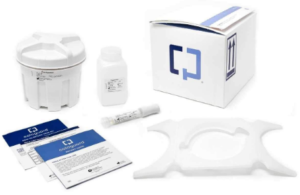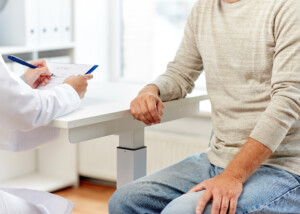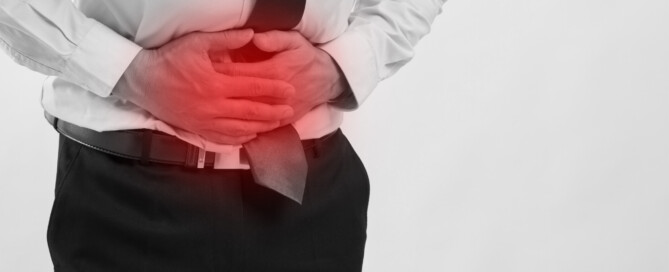Can GERD Cause You to Vomit in the Morning after Waking?

“GERD can cause symptoms of nausea and regurgitation of food,” says Franjo Vladic, MD. Morning nausea can make you vomit…sort of. (more…)
Miralax Does NOT Cause Thin Stools; Colon Cancer Can

Don’t get your hopes up that your newly narrow stools are a side effect of Miralax.
“The mechanism of action for Miralax causes water retention in stool, producing a laxative effect,” explains Franjo Vladic, MD, a board certified gastroenterologist with Center for Digestive Health and Endoscopy Center in Ohio.
Dr. Vladic continues, “Consequently, the individual’s stool should ‘bulk’ up the stool, rather than appear thin or small.
“If the individual has small thin stools they should seek medical attention to ensure no organic pathology is causing the symptom.”
Skinny BMs are sometimes referred to as “narrow” or “pencil thin.” Sometimes the term “ribbon” comes up.
Bowel movements that suddenly begin taking on this kind of appearance, like Dr. Vladic says, are not being caused by Miralax.
However, thin stools can be caused by irritable bowel syndrome, a colon polyp, or…colon cancer. But don’t panic just yet.
First be sure that what you’re seeing coming out of you and into the toilet bowl are truly, genuinely pencil-shaped poops.
Are they actually narrow, skinny or like a ribbon?
If the cause is a colon polyp or cancer, this is because the polyp or tumor is partially obstructing the opening through which bowel movements are voided — if the tumor is close enough to that opening.
Only so much, then, of the feces can get squeezed through this smaller opening, and hence, the fecal matter comes out almost like how toothpaste comes out of a tube.
Again, Miralax is not the cause of thin stools, even though the timing of you taking the Miralax may coincide with this change in bowel movement appearance.
In fact, nowhere on drugs.com does it state that skinny or thin stools can be caused by Miralax, though the site does point out that more frequent BMs can result.
The site lists additional possible side effects such as gas, diarrhea, rectal pain, stomach pain, cramping, bloating and nausea, plus more serious side effects such as difficulty breathing and tightness in the chest.
What are the odds that colon cancer is causing your stools to be thin?
There is no data out as far as percentage, as in, “Based on your age and dietary habits, there’s a 40 percent chance that your skinny poops are due to colon cancer.”
Though the vast majority of colon cancer cases occur to people over the age of 50, people in their 30s, even 20s, have been known to develop this illness — though it’s quite rare in this age group.
Now that you know that Miralax likely is not the cause of your thin or narrow stools — according to Dr. Vladic — you might want to take a home colon cancer screening test called Cologuard — just to gain more reassurance.

The Cologuard kit
Cologuard is simple to use. You collect a BM sample and mail it off.
Cologuard uses state of the art DNA technology to identify abnormal cells in your sample.
Though Cologuard does not diagnose colon cancer, it’s excellent for detecting suspicious looking cells, and from that point, your doctor can recommend a colonoscopy.
Cologuard must be ordered by your doctor.
If your doctor has not heard of Cologuard, give him or her Cologuard’s number: 1-844-870-8870. New-onset thin stools should never be ignored.

Dr. Vladic’s special interests include acid reflux, colitis, colon cancer, GERD, heartburn, IBS, liver disease, obesity, pancreatitis and peptic ulcer, among many others.
 Lorra Garrick has been covering medical, fitness and cybersecurity topics for many years, having written thousands of articles for print magazines and websites, including as a ghostwriter. She’s also a former ACE-certified personal trainer.
Lorra Garrick has been covering medical, fitness and cybersecurity topics for many years, having written thousands of articles for print magazines and websites, including as a ghostwriter. She’s also a former ACE-certified personal trainer.
Source: drugs.com/sfx/miralax-side-effects.html
Can Canned Beets Cause Red in Stools?

If you see what looks like blood in your poops, this COULD be from the canned beets you ate yesterday.
The sight of this in the toilet bowl has been known to freak people out because to the inexperienced, the coloration looks like blood.
Those Blasted Beets
“Beets and many berries, along with some medications, all have the ability to color urine or stool,” says Franjo Vladic, MD, a board certified gastroenterologist with Center for Digestive Health and Endoscopy Center in Ohio.
Dr. Vladic continues, “Beets are the most notorious culprit, causing urine to redden within hours, and depending upon transit time, can cause stool to look redder for days.”
Next time this happens to you, take images of the contents of the toilet bowl to keep it handy for reference for when it occurs again.
You can also present the image to your doctor if you’re concerned enough to get an exam.
Your doctor will want to know if, in addition to the red in your stools, you have other new symptoms such as nausea, abdominal pain, unexplained weight loss or fatigue, and a feeling of constipation even after you have voided.
Canned Beets: Anything Unique?
There is nothing about the canning process, though, that would make canned beets more likely or less likely to redden your stools when compared to fresh beets (raw or cooked).
Whether beets come in a can, raw in a salad or cooked after coming from the produce department, this superfood contains betaine, the pigment that causes red to appear in the stools and urine of a small percentage of people.
This is a perfectly benign situation, though scary to those who are not familiar with it.

Dr. Vladic’s special interests include acid reflux, colitis, colon cancer, GERD, heartburn, IBS, liver disease, obesity, pancreatitis and peptic ulcer, among many others.
 Lorra Garrick has been covering medical, fitness and cybersecurity topics for many years, having written thousands of articles for print magazines and websites, including as a ghostwriter. She’s also a former ACE-certified personal trainer.
Lorra Garrick has been covering medical, fitness and cybersecurity topics for many years, having written thousands of articles for print magazines and websites, including as a ghostwriter. She’s also a former ACE-certified personal trainer.
.
Top image: Shutterstock/Lepas
Can Cancer Cause Food to Hurt Going Down Your Chest?
Does food lately hurt going down your chest and you can’t help but wonder if this means cancer?
Cancer can cause chest pain depending on where the tumor is located.
For instance, lung cancer can actually cause chest pain. So can bone cancer and lymphoma (cancer of the lymph nodes).
However, we are talking specifically about pain or discomfort WHILE food is going down your chest.
“Odynophagia is pain caused by food traveling down in the chest,” says Franjo Vladic, MD, a board certified gastroenterologist with Center for Digestive Health and Endoscopy Center in Ohio.
Why can food going down your chest sometimes hurt?
Dr. Vladic says, “The pain receptors in the esophagus can cause esophageal chest pain. This can be caused by infection, esophageal ulcers and esophageal dysmotility (irregular contractions of the esophageal muscles).”
Odynophagia can also be caused by rapid eating of certain kinds of food, though it’s more of a pressure type of aching rather than a pain.
The food in particular that causes this, while eating it rapidly, is bread.
Due to its texture, bread can be wolfed down rapidly in large amounts, but because it’s more solid than mashed potatoes or pudding, it can create a bottleneck in the esophagus.
The esophagus runs down the chest from the throat, linking the throat to the stomach organ. If you have clumps of bread in there, it’s going to be uncomfortable.
A malignant tumor in the esophagus rarely causes actual pain. But it’s not impossible.
When you’re swallowing food, a tumor that’s large enough will cause the food to feel stuck. This is the premier symptom of esophageal cancer.
Can the causes of ogynophagia LEAD to cancer, such as colon cancer?
Certainly not. But if you’re concerned about colon cancer but are either afraid of having a colonoscopy or too young to be considered a candidate for a colonoscopy, you can give yourself a home screening test with Cologuard.

With Cologuard, which is available only by a prescription, you collect a stool sample and mail it off.
Cologuard uses advanced DNA technology to identify abnormal cells.
If your doctor has not heard of Cologuard, give him or her the Cologuard number: 1-844-870-8870.
In the meantime, slow down your eating, especially that of bread, and drink more fluids in between mouthfuls, to see if that doesn’t eliminate that hurt in your chest when food goes down.

Dr. Vladic’s special interests include acid reflux, colitis, colon cancer, GERD, heartburn, IBS, liver disease, obesity, pancreatitis and peptic ulcer, among many others.
 Lorra Garrick has been covering medical, fitness and cybersecurity topics for many years, having written thousands of articles for print magazines and websites, including as a ghostwriter. She’s also a former ACE-certified personal trainer.
Lorra Garrick has been covering medical, fitness and cybersecurity topics for many years, having written thousands of articles for print magazines and websites, including as a ghostwriter. She’s also a former ACE-certified personal trainer.
.
Top image: Freepik/KamranAydinov
Why You Have a Sore Stomach when Awakening
The causes of a sore stomach when awakening are many, including colon cancer and other organ cancers. (more…)
White Film on Stools: Benign Mucus or Cancer?

Cancer cell
Are you seeing clumps of white goop or film with your poops? Cancer may come to mind.
As yucky or scary as this white film or goop looks when it’s mixed with your stools, you can be reassured it is not a sign of cancer.
“White film, which forms on top of the stool, usually is caused by steatorrhea (fat in or on the stools),” says Franjo Vladic, MD, a board certified gastroenterologist with Center for Digestive Health and Endoscopy Center in Ohio.
“Other symptoms of steatorrhea may include abdominal pain or cramping, the stool floating on top of the toilet water (think of how vinegar floats on water), or foul-smelling stool.”
The white film is sometimes referred to as mucus. “Mucus is a jelly-like substance,” says Dr. Vladic.
“The presence of mucus in stool is common. Mucus is usually clear but it may also appear white or yellow in color.
“There are no specific symptoms associated with mucus in stools.
“It can be produced from the intestinal lining, which is a normal physiological process to help with transit of your poops through the colon to be voided, and there is no diagnosis associated with mucus in stools.”
Thank goodness! So you now no longer have to feel fear upon seeing those white filmy blobs or clumps with your stools.
Their presence may be often or intermittent. You can now just ignore them.
But if the white film in your stools has got you wondering about colon cancer…again, rest assured, this is not a symptom of colon cancer (or any other cancer).
Cologuard
And by the way, you can do a home screening for colon cancer with Cologuard, a simple to use test that your doctor can prescribe for you if you’re not yet ready to undergo a colonoscopy.

The Cologuard kit enables you to gather a sample of your poop and mail it off so that it can be analyzed with the most advanced DNA technology.
This technology will identify, if present, suspicious looking cells in the sample.
If your doctor has not heard of Cologuard, here is the Cologuard number: 1-844-870-8870.

Dr. Vladic’s special interests include acid reflux, colitis, colon cancer, GERD, heartburn, IBS, liver disease, obesity, pancreatitis and peptic ulcer, among many others.
 Lorra Garrick has been covering medical, fitness and cybersecurity topics for many years, having written thousands of articles for print magazines and websites, including as a ghostwriter. She’s also a former ACE-certified personal trainer.
Lorra Garrick has been covering medical, fitness and cybersecurity topics for many years, having written thousands of articles for print magazines and websites, including as a ghostwriter. She’s also a former ACE-certified personal trainer.
.
Top image: Shutterstock/Kateryna Ko
Colon Cancer Nausea vs. IBS Nausea
Is there a difference in the way nausea feels when it’s caused by cancer vs. IBS?
Or is all nausea the same, whether it’s caused by cancer or irritable bowel syndrome?
Nausea, regardless of whether it’s from colon (or liver, for that matter) cancer or IBS, in and of itself feels the same.
“Nausea” is a symptom that refers to a sick feeling in one’s stomach that makes them feel as though vomiting is imminent.
Nausea can feel mild, moderate or severe, and can come in waves or be persistent — whether you have irritable bowel syndrome or colon cancer.
Colon Cancer Nausea vs. IBS
“Colon cancer related nausea versus IBS related nausea needs to be considered in regards to whether ‘alarm’ symptoms are present,” says Franjo Vladic, MD, a board certified gastroenterologist with Center for Digestive Health and Endoscopy Center in Ohio.
“Alarm symptoms are present in organic pathology conditions causing nausea like colon cancer, and should be addressed with a medical professional,” continues Dr. Vladic.
“Alarm symptoms are absent in IBS related nausea symptoms.”
The following are alarm symptoms, but keep in mind that if you have some of these, this doesn’t mean you necessarily have a malignant tumor.
- Symptom onset after the age of 50 yrs. old
- Severe or progressively worsening symptoms
- Unexplained weight loss (can also be caused by diabetes, celiac disease, hyperthyroidism, inflammatory bowel disease)
- Unexplained iron deficiency, anemia
- Nighttime symptoms
- Fevers or chills
- Rectal bleeding (can also be caused by hemorrhoids or anal tears)
- Family history of colon cancer or inflammatory bowel disease (ulcerative colitis, Crohn’s) or celiac sprue
Additional alarm symptoms are as follows:
1 Unexplained fatigue
2 Pencil-thin or ribbon-like stools
3 Constipation, especially if in between episodes of constipation there is diarrhea.
The biggest alarm may be the persistence and progression of any symptoms that you do have along with the nausea — a set of symptoms that are not going away.
For women, if a workup by your gastroenterologist comes out negative for colon cancer, and even if you’re diagnosed with IBS, you may want to consider having an exam of your ovaries by an OBGYN.
Some of symptoms of ovarian cancer, including nausea, are the same as that of colon.
The symptoms of a benign ovarian cyst are virtually identical to that of ovarian cancer.
Cologuard
Cologuard is an easy home screening tool for colon cancer that uses the most advanced DNA technology to detect abnormal cells in your fecal sample.

Cologuard is a smart option for those who are not yet up to having a colonoscopy.
Cologuard isn’t a diagnostic tool, only a screening tool, and depending on the sample results, your doctor will discuss whether or not you should have a colonoscopy.
And by the way, if you’ve been diagnosed with IBS and suffer from nausea as a result, you should not disregard any alarm symptoms that crop up in the future; after all, IBS doesn’t make a person immune to colon cancer!

Dr. Vladic’s special interests include acid reflux, colitis, colon cancer, GERD, heartburn, IBS, liver disease, obesity, pancreatitis and peptic ulcer, among many others.
 Lorra Garrick has been covering medical, fitness and cybersecurity topics for many years, having written thousands of articles for print magazines and websites, including as a ghostwriter. She’s also a former ACE-certified personal trainer.
Lorra Garrick has been covering medical, fitness and cybersecurity topics for many years, having written thousands of articles for print magazines and websites, including as a ghostwriter. She’s also a former ACE-certified personal trainer.
.
Top image: Shutterstock/9nong
Can Chronic Pancreatitis Be Caused By Cancer?

You have that backwards; chronic pancreatitis will increase the risk of cancer!
This means that if you have chronic pancreatitis, you probably don’t have cancer, but you DO carry the risk of it down the road—to your pancreas. (more…)
Tall Teen Girls Should Wear High Heels for Self-Confidence

Parents should NEVER discourage their very tall teen daughters from wearing high heels.
Otherwise this sends a very bad message.
If your daughter knows that you feel awkward about her extra height, you’re doing something wrong and it needs to get fixed.
(more…)
At What Age Should Kids Stop Screaming While Playing?

At what point are kids too old to be screaming during play?
What’s that cutoff where it goes from magical to obnoxious? (more…)



































































